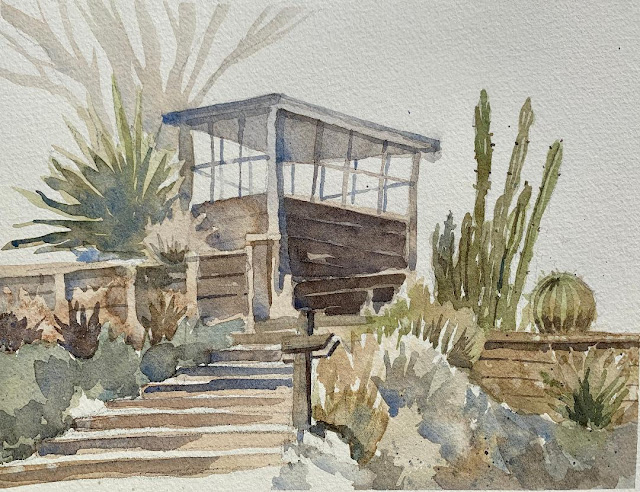S l o w
For this past Thursday's paintsite, we went to UC Santa Cruz's lovely Arboretum, and I was instantly taken by this structure - this Japanese looking glass cube perched above the Succulent Garden. I found out later when I went up the steps to look inside it that it
- was called "Owl Observatory"
- contained inside it a cracked concrete slab with two empty chairs facing each other
- was a charming wood structure with what looked like a skylight inside, but instead of glass, had a wood panel on which was painted Saturn that (possibly) glows at night
- contained an old framed black and white photograph of ITSELF - of the structure from the outside. ... a self-reflective device.
I did a small compositional study, though I had an idea in my mind of what the composition would be - vertical, with stairs leading up to this structure. I followed the whites/light areas as I looked at the scene, and made some things lighter than they were simply to keep my whites connected. I tried a triad of colors for the color scheme, but decided it wasn't muted enough for the scene I wanted to paint.
One big difference as I painted was that I was s l o w. I took my time putting paint on the paper. I took my time letting it dry. I wasn't slapdashing, doing big strokes, and dry brushing right off the bat. I was using a big brush, and had my puddles of color ready to dip into. But I took my time. I let the paint dry. I thought for a few seconds about what I would do before I did it. Once I started doing it, I wasn't hesitant, and I didn't slow down and think. I went for it. But I went for it slowly.
And I realized - that when you learn something new, as well as learning the new thing, YOU CHANGE. Your character changes - and it is not just because of the new knowledge that you have, but how your character molds around the acceptance of the new knowledge. I've written about how I am learning patience as I do watercolor - I have to be patient to let the layers dry, to not want to go in with new color when the previous color is still too wet. That has taught me to be more patient in other parts of my life as well. And I have also written about how one needs to let go, and give up control, when learning watercolor. These two skills inevitably slip into other parts of life as well, and you cannot help but be more patient and less controlling in watercolor and elsewhere where it might matter.
I also realized that the watercolors I am drawn to almost always have these things:
- connected whites - not just lights, but WHITE of the paper
- layers - new layers that don't entirely cover old layers but let old layers show through, not just translucently under old layers, but in pockets in between, essentially revealing a history of how that watercolor was painted
- negative painting - adds complexity and depth that positive painting simply cannot on its own
- negative painting - adds complexity and depth that positive painting simply cannot on its own
- constant changes of color
- watermarks and texture, accidental or deliberate.




Comments
Post a Comment